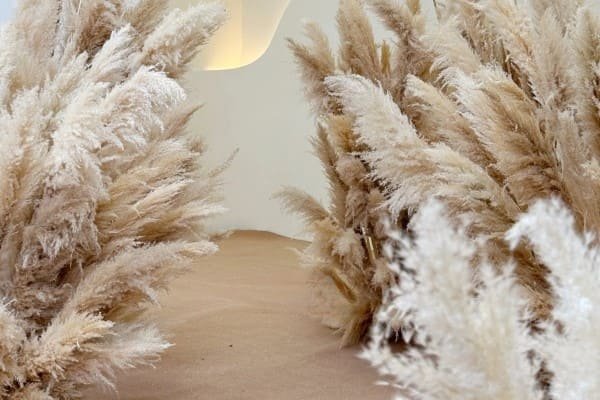


Pampas grass, with its feathery plumes and tall, graceful stems, has become a popular choice for dried floral arrangements and home decor. But beyond its modern aesthetic appeal, Pampas grass has a rich history and intriguing origins that stretch back to the grasslands of South America. This article delves into the history, cultivation, cultural significance, and contemporary uses of dried Pampas grass, providing a comprehensive look at this versatile plant.
Pampas grass (Cortaderia selloana) is native to the vast grasslands of the Pampas region in South America, which spans across Argentina, Brazil, and Uruguay. These grasslands are characterized by their open, flat terrain and moderate climate, which provides ideal growing conditions for this hardy, perennial grass. The name "Pampas" itself comes from the Quechua word "pampa," meaning "plain," reflecting the expansive flatlands where this grass naturally thrives.
The plant was first described scientifically in the early 19th century by botanist Alexander von Humboldt and botanist Aimé Bonpland during their exploration of South America. It was later classified by the German botanist Friedrich Sello, who named the species Cortaderia selloana in his honor.
In its native regions, Pampas grass plays a significant role in the local ecosystem. It provides habitat and food for various species of wildlife, including birds, insects, and small mammals. The dense, tall plumes of the grass offer shelter and nesting sites, particularly for birds.
Culturally, Pampas grass has been used by indigenous communities for centuries. The tough, fibrous leaves of the plant were traditionally used to make ropes, mats, and baskets, while the tall stems were often utilized as building materials. In rural areas, Pampas grass was sometimes used as a natural windbreak to protect crops from harsh winds.

Pampas grass was introduced to Europe in the mid-19th century, where it quickly became a popular ornamental plant. Its striking plumes and tall, graceful stems made it a favored choice for Victorian gardens and estate landscapes. By the late 19th century, the plant had made its way to North America, where it was also embraced for its decorative qualities.
However, Pampas grass's adaptability and rapid growth soon led to concerns about its invasive potential. In some regions, particularly in California, the plant spread aggressively, outcompeting native vegetation and disrupting local ecosystems. Despite these concerns, Pampas grass continued to be cultivated and utilized for ornamental purposes.
The use of dried Pampas grass in home decor and floral arrangements has seen a resurgence in recent years, particularly within the bohemian and minimalist design trends. The grass's soft, neutral tones and airy, textured plumes make it a versatile element that complements various interior styles.
Dried Pampas grass is valued for its longevity and low maintenance requirements. Unlike fresh flowers, which wilt and require water, dried Pampas grass can last for years with minimal care. Its ability to add height, texture, and a touch of nature to indoor spaces has made it a staple in contemporary decor.
The process of harvesting and drying Pampas grass is relatively straightforward, but it requires careful timing to ensure the best results. The plumes are typically harvested in late summer or early autumn when they are fully mature and have developed their characteristic fluffy appearance.
To dry Pampas grass, the stems are cut and hung upside down in a cool, dry place with good air circulation. This allows the moisture to evaporate gradually, preserving the plumes' structure and preventing mold growth. Once dried, the stems can be trimmed and arranged as desired.
Some enthusiasts also choose to treat the dried plumes with a light coat of hairspray to reduce shedding and maintain their shape. This extra step can help extend the life of the dried Pampas grass, making it an even more durable decor option.
In addition to its use in home decor, dried Pampas grass has become a popular choice for weddings and special events. Its neutral color palette and elegant form make it a versatile component in bouquets, centerpieces, and ceremony backdrops. Many couples opt for Pampas grass to create a bohemian or rustic-chic aesthetic, often pairing it with other dried or fresh flowers.
The eco-friendly nature of dried Pampas grass has also contributed to its popularity. As a sustainable alternative to fresh flowers, it appeals to environmentally conscious consumers looking to reduce waste and minimize their carbon footprint.
Pampas grass's adaptability extends to its use in various crafts and DIY projects. From wreaths and garlands to wall hangings and table arrangements, the possibilities for creative expression with Pampas grass are nearly endless.

While Pampas grass is beloved for its decorative appeal, it has also been the subject of environmental concern due to its invasive tendencies in certain regions. In areas like California, Australia, and New Zealand, Pampas grass has spread beyond cultivated gardens and into wild landscapes, where it poses a threat to native species.
Efforts to manage and control the spread of Pampas grass include removing invasive populations, promoting the use of non-invasive alternatives, and educating the public about responsible planting practices. Some regions have also implemented regulations restricting the sale and cultivation of Pampas grass.
Despite these challenges, Pampas grass continues to be a popular and valued plant in the world of horticulture and design. Its enduring appeal lies in its ability to bridge the gap between nature and art, bringing the beauty of the wild into the human-made environment.
Dried Pampas grass, with its rich history and cultural significance, has evolved from a humble grass of the South American plains to a beloved decorative element in homes and events worldwide. Its journey from the wild Pampas to the living rooms and wedding venues of the modern world is a testament to its enduring beauty and versatility. Whether used for its aesthetic appeal, its ecological benefits, or its cultural symbolism, Pampas grass remains a timeless and adaptable plant that continues to capture the imagination of people across the globe.